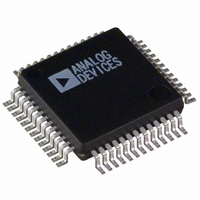ADUC831BS Analog Devices Inc, ADUC831BS Datasheet - Page 48

ADUC831BS
Manufacturer Part Number
ADUC831BS
Description
IC ADC/DAC 12BIT W/MCU 52-MQFP
Manufacturer
Analog Devices Inc
Series
MicroConverter® ADuC8xxr
Datasheet
1.EVAL-ADUC831QSZ.pdf
(76 pages)
Specifications of ADUC831BS
Rohs Status
RoHS non-compliant
Core Processor
8052
Core Size
8-Bit
Speed
16MHz
Connectivity
EBI/EMI, I²C, SPI, UART/USART
Peripherals
PSM, Temp Sensor, WDT
Number Of I /o
34
Program Memory Size
62KB (62K x 8)
Program Memory Type
FLASH
Eeprom Size
4K x 8
Ram Size
2.25K x 8
Voltage - Supply (vcc/vdd)
2.7 V ~ 5.5 V
Data Converters
A/D 8x12b, D/A 2x12b
Oscillator Type
Internal
Operating Temperature
-40°C ~ 125°C
Package / Case
52-MQFP, 52-PQFP
For Use With
EVAL-ADUC831QSZ - KIT DEV FOR ADUC831 QUICK START
Available stocks
Company
Part Number
Manufacturer
Quantity
Price
Company:
Part Number:
ADUC831BS
Manufacturer:
SHARP
Quantity:
21 512
Company:
Part Number:
ADUC831BS
Manufacturer:
ADI
Quantity:
150
Part Number:
ADUC831BS
Manufacturer:
ADI/亚德诺
Quantity:
20 000
Company:
Part Number:
ADUC831BSB20
Manufacturer:
MINI
Quantity:
892
Company:
Part Number:
ADUC831BSZ
Manufacturer:
Analog Devices Inc
Quantity:
10 000
Part Number:
ADUC831BSZ
Manufacturer:
AD
Quantity:
20 000
Company:
Part Number:
ADUC831BSZ-REEL
Manufacturer:
AD
Quantity:
1 200
Company:
Part Number:
ADUC831BSZ-REEL
Manufacturer:
Analog Devices Inc
Quantity:
10 000
ADuC831
In general-purpose I/O port mode, Port 2 pins that have 1s written
to them are pulled high by the internal pull-ups (Figure 39) and,
in that state, they can be used as inputs. As inputs, Port 2 pins
being pulled externally low will source current because of the
internal pull-up resistors. Port 2 pins with 0s written to them
will drive a logic low output voltage (V
sinking 1.6 mA.
P2.6 and P2.7 can also be used as PWM outputs. In the case that
they are selected as the PWM outputs via the CFG831 SFR, the
PWM outputs will overwrite anything written to P2.6 or P2.7.
Port 3
Port 3 is a bidirectional port with internal pull-ups directly con-
trolled via the P3 SFR. Port 3 pins that have 1s written to them
are pulled high by the internal pull-ups, and in that state, can be
used as inputs. As inputs, Port 3 pins being pulled externally low
will source current because of the internal pull-ups. Port 3 pins
with 0s written to them will drive a logic low output voltage (V
and will be capable of sinking 4 mA.
Port 3 pins also have various secondary functions described in
Table XVIII. The alternate functions of Port 3 pins can only be
activated if the corresponding bit latch in the P3 SFR contains a 1.
Otherwise, the port pin is stuck at 0.
Pin
P3.0
P3.1
P3.2
P3.3
P3.4
P3.5
P3.6
P3.7
P3.4 and P2.3 can also be used as PWM outputs. In the case that
they are selected as the PWM outputs via the CFG831 SFR, the
PWM outputs will overwrite anything written to P3.4 or P3.3.
TO LATCH
INTERNAL
LATCH
FROM
PORT
LATCH
WRITE
READ
READ
BUS
PIN
Q
Table XVIII. Port 3, Alternate Pin Functions
Alternate Function
RxD (UART Input Pin) (or Serial Data I/O in Mode 0)
TxD (UART Output Pin)
(or Serial Clock Output in Mode 0)
INT0 (External Interrupt 0)
INT1 (External Interrupt 1)/PWM 1/MISO
T0 (Timer/Counter 0 External Input)
PWM External Clock/PWM 0
T1 (Timer/Counter 1 External Input)
WR (External Data Memory Write Strobe)
RD (External Data Memory Read Strobe)
Figure 39. Internal Pull-Up Configuration
Figure 38. Port 2 Bit Latch and I/O Buffer
DELAY
2 CLK
LATCH
CL
D
Q
Q
ADDR
*SEE FIGURE 39 FOR
DETAILS OF INTERNAL PULL-UP
CONTROL
Q4
Q1
DV
DD
OL
) and will be capable of
Q2
DV
DD
DV
DD
Q3
DV
DV
DD
DD
INTERNAL
PULL-UP*
P2.x
PIN
Px.x
PIN
OL
)
–48–
Additional Digital I/O
In addition to the port pins, the dedicated SPI/I
(SCLOCK and SDATA/MOSI) also feature both input and
output functions. Their equivalent I/O architectures are illus-
trated in Figure 41 and Figure 43, respectively, for SPI
operation and in Figure 42 and Figure 44 for I
Notice that in I
(Q1) is disabled, leaving only a weak pull-up (Q2) present. By
contrast, in SPI mode (SPE = 1) the strong pull-up FET (Q1)
is controlled directly by SPI hardware, giving the pin push/pull
capability.
In I
operate in parallel in order to provide an extra 60% or 70% of
current sinking capability. In SPI mode (SPE = 1), however,
only one of the pull-down FETs (Q3) operates on each pin
resulting in sink capabilities identical to that of Port 0 and
Port 2 pins.
On the input path of SCLOCK, notice that a Schmitt trigger
conditions the signal going to the SPI hardware to prevent false
triggers (double triggers) on slow incoming edges. For incoming
signals from the SCLOCK and SDATA pins going to I
ware, a filter conditions the signals in order to reject glitches of
up to 50 ns in duration.
Notice also that direct access to the SCLOCK and SDATA/MOSI
pins is afforded through the SFR interface in I
Therefore, if you are not using the SPI or I
use these two pins to give additional high current digital outputs.
2
INTERNAL
TO LATCH
C mode (SPE = 0) two pull-down FETs (Q3 and Q4)
(MASTER/SLAVE)
HARDWARE SPI
Figure 41. SCLOCK Pin I/O Functional Equivalent
in SPI Mode
LATCH
WRITE
READ
READ
BUS
PIN
Figure 40. Port 3 Bit Latch and I/O Buffer
SPE = 1 (SPI ENABLE)
2
C mode (SPE = 0) the strong pull-up FET
LATCH
D
CL
Q
Q
TRIGGER
SCHMITT
ALTERNATE
ALTERNATE
FUNCTION
FUNCTION
OUTPUT
INPUT
Q1
Q3
DV
DD
DV
DD
2
C functions, you can
Q2 (OFF)
Q4 (OFF)
INTERNAL
PULL-UP*
*SEE FIGURE 39
FOR DETAILS OF
INTERNAL PULL-UP
2
C operation.
2
C master mode.
P3.x
PIN
2
SCLOCK
C pins
PIN
2
C hard-
REV. 0













